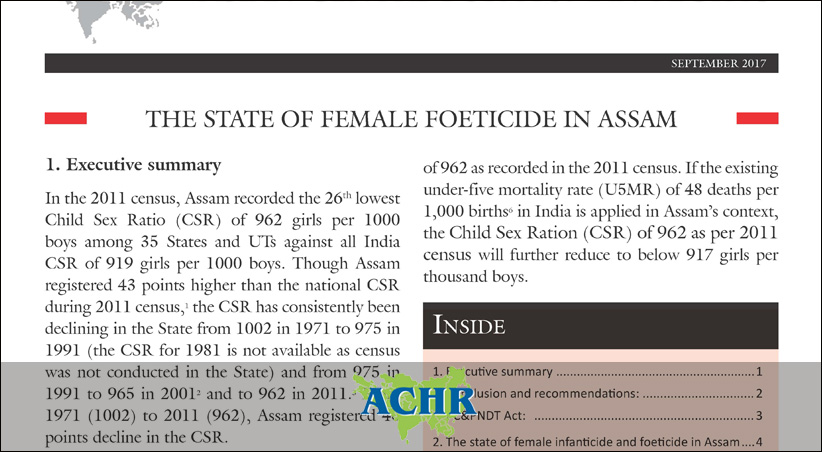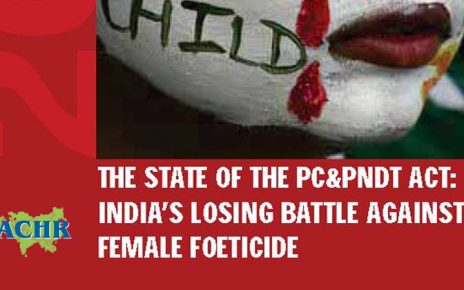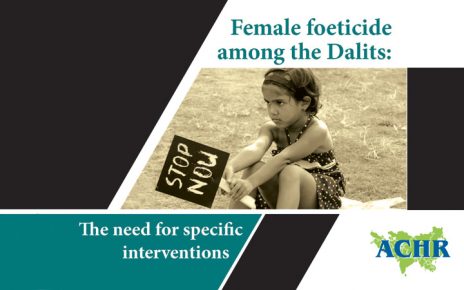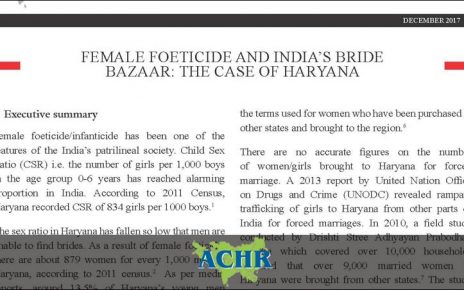In the 2011 census, Assam recorded the 26th lowest Child Sex Ratio (CSR) of 962 girls per 1000 boys among 35 States and UTs against all India CSR of 919 girls per 1000 boys. Though Assam registered 43 points higher than the national CSR during 2011 census, the CSR has consistently been declining in the State from 1002 in 1971 to 975 in 1991 (the CSR for 1981 is not available as census was not conducted in the State) and from 975 in 1991 to 965 in 2001 and to 962 in 2011. From 1971 (1002) to 2011 (962), Assam registered 40 points decline in the CSR.
In 2011 census, out of total 27 districts, 15 districts registered decline in CSR. Dhemaji district with 20 points registered the sharpest decline, followed by Karbi Anglong district (-14), Nagaon (-11), Goalpara (-11) and Morigaon (-10). Despite registering a mild improvement of 3 points, Kamrup Metropolitan district topped being the district with lowest CSR with 946, followed by Dhemaji (950), Cachar, Kokrajhar and Hailakandi districts with 954 point each.
The statistics collected for the Annual Health Survey in Assam, one of the nine high focus States with relatively high fertility and mortality account are not encouraging. As per the sample survey which claims to be the largest demographic survey in the world, Assam recorded Sex Ratio at Birth (SRB) of 937 in 2011-2012 and 947 in 2012-2013, and both figures are well below the State average CSR of 962 as recorded in the 2011 census. If the existing under-five mortality rate (U5MR) of 48 deaths per 1,000 births in India is applied in Assam’s context, the Child Sex Ration (CSR) of 962 as per 2011 census will further reduce to below 917 girls per thousand boys.
According to a written reply given by the Union Health Minister J P Nadda in the Lower House (Lok Sabha) on 27 February 2015, only five cases were filed under the Pre-Conception and Pre-Natal Diagnostic Techniques (PCPNDT) Act of 1994 (PC&PNDT) since the inception of the Act in 1994 while no conviction was secured in any of those cases. During the corresponding period, only two machines were seized or sealed while no medical license of any doctor was cancelled or suspended. The reasons for filing only five cases under the PC&PNDT Act across the state and not securing a conviction in any of these cases in Assam are not hard to find. There has been absolute lack of seriousness on the part of the State Government of Assam to implement the PC&PNDT Act.
First, Assam did not have the statutory mechanisms under the PC&PNDT Act until May 2001. Till the directions of the Hon’ble Supreme Court dated 4 May 2001 in CHEHAT case, the basic mechanisms for implementing the PC&PNDT Act was nowhere to be found, not to speak about implementing the law smoothly. Advisory Committees at the District level were constituted only through an Order dated 31 May 2001 while the officials of the District Appropriate Authorities were first appointed as late as 31 May 2001. Even the notification for constitution of the District Inspection & Monitoring Committee was issued for the first time on 11 June 2012. The State Supervisory Board (SSB) as provided under Section 16A of the PC&PNDT Act was constituted as late as 6 August 2011 while the Inspection & Monitoring Committee (SIMC) was constituted as late as 5 April 2012.
Second, State Government of Assam failed to reconstitute or appoint members of the statutory bodies of the PC&PNDT Act such as State Supervisory Board, State Advisory Committee and State Inspection and Monitoring Committee of the PC&PNDT Act on time. Because of non-appointment of members or non-reconstitution on time, these bodies remained defunct and this heavily hampered the statutory duties of these bodies.
Third, non-implementation of the decisions adopted by the statutory bodies at the state level such as the State Supervisory Board, State Advisory Committee, Multi Member Appropriate & State Inspection and Monitoring Committee by the statutory bodies at the District level.
Fourth, there has also been absolute lack of review of implementation of previous resolutions or decisions in subsequent meetings by the statutory bodies at the state level.
The Majoni scheme launched by the State Government of Assam in February 2009 to provide special financial assistance to girl children in the State failed to act as an incentive for retention of the girl child. As per estimates of the State Government of Assam the Majoni scheme which targeted to cover nearly 2.80 lakh new born girls each year, could cover only a total of 2,59,020 beneficiaries in four years from FY 2009–2010 to 2012–2013.
Conclusion and recommendations:
The Sex Ratio at Birth (SRB) figures recorded in the Annual Health Survey (AHS) conducted consecutively for three years during 2011-12 and 2012-13 in nine Empowered Action Group (EAG) States including Assam confirmed that the Majoni scheme has not been of much help to improve the sex ratio. The Annual Health Survey 2011-12 recorded sex ratio at birth of 937 female per 1000 males while the Annual Health Survey 2012-13 recorded sex ratio at birth with 947 females per 1000. The 2012-13 survey registered only mild improvement of 10 points over the previous year suggesting that the Majoni scheme had failed miserably to encourage families for retention of the girl child.
The benefits namely Rs.1,000 cash to the mother and fixed deposit of Rs.5,000 under the Majoni scheme which was calculated to yield a maturity amount of Rs. 25,000 – 30,000 when the girl child completes 18 years19 do not certainly act as incentives to parents for retention of girl children.
In order to address the continuous decline in CSR and to address the scourge of female foeticide in Assam, the Asian Centre for Human Rights recommends the following to the State Government of Uttar Pradesh:
- Launch a universal scheme providing post birth benefit of at least Rs.1.5 lakhs and educational scholarship of at least Rs.50,000 to each girl child, 20 provide educational scholarship of Rs. 50,00021 and further additional financial assistance of Rs. 1 lakh to be paid to surviving girls for assistance during marriage;
- The benefits of post birth grants, scholarship and for marriage should be entitled to all girls below 18 years of age irrespective of economic or social status of their parents;
- Undertake specific programme for increasing coverage of all families under the new scheme by connecting the programme with all hospitals;
- Upload all details of physical and financial achievements under the proposed scheme on a dedicated website and update the website regularly to provide all relevant information such as list of beneficiaries, funds sanctioned and utilization certificates;
PC&PNDT Act:
- Establish PC&PNDT Bureau of Investigation staffed by the State Police under the Department of Health and Family Welfare to assist the appropriate authorities for effective implementation of the PC&PNDT Act;
- Launch a Mukhbir Yojana to reward those providing information with amount of rewards of at least Rs 200,000 to decoys and Mukhbirs along with (i) specific incentive in the form of bond/ scheme for the unborn baby of the decoy customer apart from undertaking of not aborting the foetus under any circumstances;
(ii) specific allowance to the decoys and Mukhbirs to attend each hearing during the trials;
(iii) ensure anonymity of the complainants, informers etc to the extent possible; and
(iv) sanction adequate financial resources for implementation of the scheme in all the States and UTs;
- Introduce Integrated Monitoring system for PC&PNDT Act and installing tracking devices in all sonography machines;
- Ensure proper implementation of the PC&PNDT Act inter alia through: (a) ensuring efficient and effective system of registration of all ultrasound/ genetic clinics so as to ensure compliance with the provisions of the Act; (b) ensuring regular and effective inspection of the ultrasound/ genetic clinics for curbing the violation of Act & Rule; and (c) ensuring proper enforcement mechanism and taking appropriate action for violations of the provisions of Act;
- Ensure proper implementation of the PC&PNDT Act inter alia by (i) reconstituting or appointing members of the statutory bodies of the PC&PNDT Act such as State Supervisory Board, State Advisory Committee and State Inspection and Monitoring Committee of the PC&PNDT Act on time; (ii) ensuring strict implementation of decisions adopted by these by the statutory bodies at the District level; (iii) ensuring review of implementation of previous resolutions or decisions in subsequent meetings by the statutory bodies at the state level;
- Ensure time bound trial of the cases under the PC&PNDT Act; and
- Make necessary budgetary allocations for implementation of all these measures.




